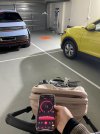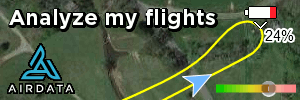I recently upgraded from the Air 3S to the Mavic 4 Pro and noticed a significant increase in noise. This aligns with DJI's official specs, which list the Air 3S at 81 dB and the Mavic 4 Pro at 83 dB. I’m puzzled by some YouTubers claiming the Mavic 4 Pro is quieter—my tests clearly show otherwise. Even at 100 meters altitude flying at moderate speed in a quiet suburban area, the Mavic 4 Pro’s noise is distinctly audible from the ground and noticeably louder than the Air 3S. The supposed "lower frequency" noise of the Mavic 4 Pro doesn’t make it any less intrusive.
Curious about drone noise reduction progress, I purchased a second hand Mavic Pro Platinum to compare with my other drones, testing whether DJI has made any strides in noise control since the Platinum’s release 8 years ago.
Test Method: I conducted tests in my garage, with each drone hovering at 1.2 meters above a landing pad. I measured noise levels using an iPhone app from a fixed position 6.5 meters away, averaging the results over an extended period.
Test Results:
Another observation which might prove this guess: the Matrice 4T is only 160g heavier than the Mavic 4 Pro but produces 2 dB more noise with default propellers. Switching to its bulky low-noise propellers, which reduce flight time, brings it down to the Mavic 4 Pro’s noise level.
Based on my testing method and corroborated by various online video reviews and DJI's published noise ratings, I’ve compiled approximate noise levels for other drones I didn’t test:
I hope this provides useful insight for others interested in drone noise performance.
Curious about drone noise reduction progress, I purchased a second hand Mavic Pro Platinum to compare with my other drones, testing whether DJI has made any strides in noise control since the Platinum’s release 8 years ago.
Test Method: I conducted tests in my garage, with each drone hovering at 1.2 meters above a landing pad. I measured noise levels using an iPhone app from a fixed position 6.5 meters away, averaging the results over an extended period.
Test Results:
- Mavic Pro Platinum: 70 dB
- Mavic 4 Pro: 72 dB
- Neo: 74 dB
- Mini 4 Pro: 64 dB
- Matrice 4T (default props): 74 dB
- Matrice 4T (low-noise props): 72 dB
Another observation which might prove this guess: the Matrice 4T is only 160g heavier than the Mavic 4 Pro but produces 2 dB more noise with default propellers. Switching to its bulky low-noise propellers, which reduce flight time, brings it down to the Mavic 4 Pro’s noise level.
Based on my testing method and corroborated by various online video reviews and DJI's published noise ratings, I’ve compiled approximate noise levels for other drones I didn’t test:
- Mavic Pro: ~74 dB
- Mavic 2 Pro/Zoom: ~71 dB
- Mavic 3/3 Pro: ~71 dB
- Air 3/3S: ~70 dB
- Phantom 4: ~82 dB
I hope this provides useful insight for others interested in drone noise performance.




 It paints a clear picture of where we are right now in terms of drone noise production.
It paints a clear picture of where we are right now in terms of drone noise production.






